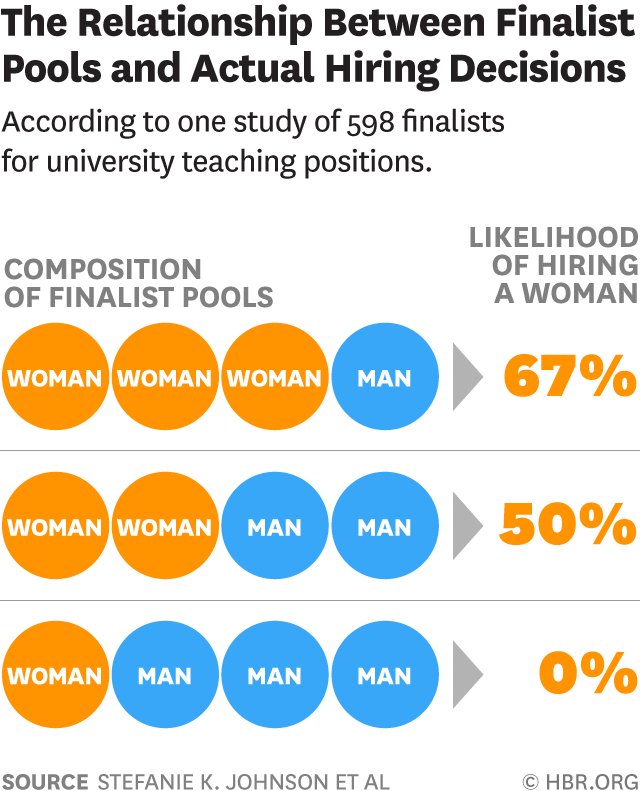Increase talent pool diversity.
Many organizations’ employee referrals feed their talent pools. That is a recruiting strategy in which employers encourage current employees to refer qualified candidates for jobs in their organizations. When there is a “war for talent,” organizations even give monetary bonuses to employees whose referrals become recruits.
Affinity bias and discomfort with what is “different” result in homogeneous networks. Unsurprisingly, candidate profiles resemble your current employees when they refer future candidates. That makes employee referrals an ineffective strategy for HR departments looking to expand their candidate pool.
Let’s explore three actions that will help increase talent pool diversity.
Action 1: assess your applicant pool
Action 1: Assess your applicant pool.
First, gain insight into your current situation to improve diversity in your applicant pool.
Gather data to measure and assess diversity gaps. This data will help you prioritize and define targeted actions with a significant impact. Go through the following checklist to evaluate your talent pool diversity.
- What do you know about diversity in your talent pool? Which socio-demographic applicant data do you have access to because candidates share it on their resumé or during an interview?
- What data do you save anonymously in a database that allows you to process the data further?
- Does the data go beyond age and gender? For example, do you look at other characteristics like ethnicity, parental status, educational background, etc.?
- What are ways to gather more data, keeping privacy and data protection laws in mind? Who can help with this task?
After collecting data, what happens to it? What does your process look like, and who is involved?
- Do you regularly check what you can learn from this data?
- Do you regularly report conclusions to senior management?
- Do you follow up with specific trends, e.g., the lack of candidates representing a particular age group or only receiving candidates from the same university?
- Do you investigate the root causes for trends? E.g., your organization gives guest lectures at only one university or is present at job fairs in certain regions.
![]()
Always check which data protection regulations apply when collecting and processing personal data. That can be your organization’s own Candidate Data Privacy Policy or national or international law (e.g., GDPR in European legislation).
Data protection laws allow you to collect and save personal data when it is:
- Non-mandatory for candidates to provide this data. Meaning they always have the option “I prefer not to say.”
- 100% anonymous.
These guidelines allow you to map your candidate pool without endangering the candidate’s privacy. Always explain to candidates why you are collecting this data, i.e., to improve diversity. In addition, it is an opportunity to showcase your commitment to DEI.
Action 2: sourcing candidates
Action 2: Sourcing candidates.
Be proactive in sourcing candidates from diverse backgrounds and experiences.
A recommended quick win to source candidates with profiles that differ from your usual candidates is reviewing and rewriting your job advertisement and website texts to make them more inclusive. You can find a step-by-step manual to do so here.
Communication with candidates goes beyond your job postings. Pay attention to the entire hiring, selection, and onboarding process.
Have you checked the language you use in:
- Private LinkedIn messages to possible candidates.
- Emails candidates receive after applying, including general automatic replies or personal emails from recruiters.
- The language you use in a first screening call.
- …
![]()
Gender is a popular element to consider when checking for inclusive language. Recruiting female employees is challenging in many sectors, so a gender focus makes sense. In addition, tips and tricks are widespread, which makes it an easy topic to start with.
We encourage you to look beyond gender.
- Besides women, what other groups are you not reaching with your job advertisements?
- Have you considered age, educational background, socio-economic background, ethnicity, first language, religion, caring responsibilities, etc.?
- Have you checked your language for historical and socio-cultural references that might exclude or offend candidates?
Recruiting from your or your employees’ networks is ineffective for a diverse talent pool. Instead, expand your network, connect with new networks, and look for external partners to advertise broadly.
Partner #1 Organizations or networks of people belonging to minorities or underrepresented groups.
Recruitment does not have to be their core business. You can make valuable new connections by networking and gain insights by listening and exchanging experiences. That can benefit your recruitment efforts in the future.
Give back to these networks by offering mentorship to their members. You can establish a personal connection between your organization and diverse talents, make a difference in someone’s career, and maybe even find a good match for one of your job openings.
E.g., A Seat At The Table. A mentoring program for underprivileged young people and a leadership program for students and young professionals.
#SheDIDIT Talent pool. #SheDIDIT is where all women with diverse cultural backgrounds can grow into their potential and develop more entrepreneurial skills. The #SheDIDIT talent pool is the first platform for entrepreneurial women with diverse cultural backgrounds in Belgium.
Partner #2 Professional organizations that aim to match candidates with organizations that carry a heart for DEI can help you find suitable candidates.
You have the same goal: finding the best possible match for candidates from diverse backgrounds and experiences. Candidates have enjoyed coaching and have great self-knowledge and insights about their added value—a true win-win.
E.g., Nestor. An employment agency for people over 50 of age and pensioners that matches motivated mature employees with flexible long-term assignments.
De werkplekarchitecten. An independent not-for-profit that trains, coaches, and guides underprivileged candidates to find a place in the labor market.
Keep Dreaming. A non-profit working towards increasing ethnic diversity and racial equality in workplaces, supporting individuals and businesses.
Partner #3 Open access diversity job boards and social network groups.
Candidates who browse these platforms self-identify as belonging to an underrepresented group in the workplace. They are actively looking for an inclusive employer. Depending on the job board, they might have specific experiences or backgrounds that can be valuable to your organization.
These job boards help you reach new networks and allow you to show you are an employer interested in a diverse talent pool.
E.g., Diversifying. A UK-based purpose-led careers platform for people to find jobs with employers serious about diversity and inclusion and for employers to showcase their jobs to a diverse community.
KifKif Job forum by the intercultural movement KifKif that builds a solidary, democratic, and intercultural society. It collects job postings from organizations and institutions with a warm heart for diversity.
Action 3: composing a shortlist
Action 3: Composing a shortlist.
You know what your talent pool looks like and how to find diverse candidate profiles.
How can you make sure you transfer the diversity in your talent pool onto your shortlist?
Define clear, appropriate, and realistic targets for shortlists before selecting candidates. Then, use your DEI Strategy as a guide to define the balance you need to create change in your recruitments.
Apply the “Two in the pool” method suggested by Johnson and colleagues (2016). This method shows that at least two diverse/minority candidates are needed to create a realistic chance for the minority candidate to be hired.

“Why does being the only woman in a pool of finalists matter? For one thing, it highlights how different she is from the norm. And deviating from the norm can be risky for decision-makers, as people tend to ostracize people who are different from the group. For women and minorities, having your differences made salient can also lead to inferences of incompetence.
Managers need to know that working to get one woman or minority considered for a position might be futile because the odds are likely slim if they are the lone woman or nonwhite candidate. But if managers can change the status quo of the finalist pool by including two women, then the women have a fighting chance.” (Johnson et al., 2016)
Learn to set targets like a pro.
The next step is to dive into your candidate pool to select candidates for your shortlist.
Consider:
- The objective job requirements and skills needed.
- The identified gaps from your DEI scan that are in your DEI Strategy.
Beware of bias in the recruitment process. Find more information on how to avoid the negative impact of bias as a recruiter or hiring manager here.
After making the first selection, ensure your shortlist includes diversity in candidates. Did you apply the “Two in the pool” method?
Reaching the set diversity targets for your shortlist can be difficult. In this case, review your candidate requirements critically.
- Why are you losing candidates with diverse profiles?
- Are there specific requirements that form a barrier?
- Can you change or redefine requirements in your job descriptions to make a more diverse shortlist possible?
It can also be necessary to evaluate the candidate’s journey or experience. For example, are you losing candidates with a diverse profile at certain stages of the recruitment and selection process? When and why is this happening? You can find more tips on improving your talent acquisition process here.
![]()
Are you working with a recruitment agency? Inform them about your desire to have a diverse shortlist.
Challenge recruitment agencies you are working with. Ask them about the diversity among their recruiters, their awareness of the importance of DEI, and their eagerness to work with organizations that address diversity needs.
What if you do not meet the diversity targets for your shortlist?
- What is the reason?
- Who is accountable? How can you hold them responsible?
- Is there a possibility to rereview the shortlist?
Some CEOs require a personal email from recruiters or hiring managers to explain the lack of diversity in a shortlist. That can seem like an extreme action, but it is one way of keeping your recruitment team on their toes.
What tools does your organization have to install accountability? Reflect on this with your team of recruiters and hiring managers.
![]()
Many organizations invest in their talent pool and talent pipeline and consider it a job well done once they manage to attract diverse talents.
Successfully recruiting candidates with different skills, points of view, and experiences is only the first step. Do not forget to invest in an inclusive culture to ensure retention. Discover actions to build an inclusive organizational culture here.
Become a DEI expert.
This is a collection of articles that allows you to take a deep dive.







